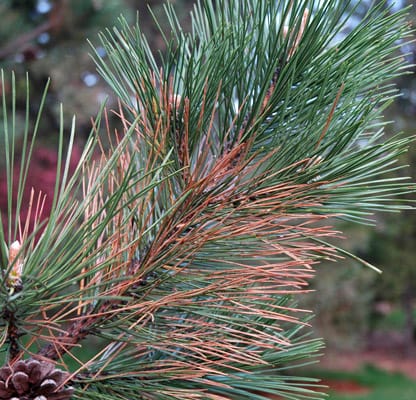Source(s): Laurene Hall
There are several types of Needle Blight diseases that effect plants. Pestalotiopsis sp. is a type of needle blight fungal disease that is considered usually a minor disease. It attacks foliage that has been injured or weakened by unfavorable weather or growing conditions. Usually, the killed foliage is near the base of the plant and where foliage is relatively dense. The disease may kill the smaller twigs where the infected needles died.
IDENTIFICATION
The Blight usually starts at the tip of the foliage and progresses towards the leaf base. The color of the foliage goes from green to yellowish, then to a dark brown that can look almost black. Twig tips turn tan to brown in color and have black, pimple-like fungal fruiting structures dotting their surface
APPEARANCE
Infections can occur anytime of the year. In the spring, when weather conditions are favorable, fungal populations can increase very rapidly and disease losses can be severe. Factors that favor disease include frost during early shoot development; cool, wet weather in spring or fall; pruning wounds; and heavy vegetative growth early or late in the season brought on by high nitrogen applications. Most importantly, this disease often affects trees that have suffered from stress (whether it is cultural, mechanical or environmental).
HOSTS
Various species of trees, shrubs, and other ornamental plants can potentially develop the disease. However, some plants are more susceptible than others. Particularly, needled evergreens, conifers, and some varieties of juniper are most susceptible. The presence of the correct environmental factors will decide whether or not a plant will develop this disease from causal agents. Additionally, wind-driven rain, insects and contaminated pruning tools all spread the fungus from plant-to-plant
INTEGRATED PEST MANAGEMENT(IPM) CONTROL
Control is to prune out dead foliage and twigs as soon as possible. Reduce winter injury by minimizing dehydration. Do not allow snow to accumulate or remain up and around the base of the plant for any length of time – especially during melting. Avoid over crowding the plants to allow sufficient sunlight and air circulation. Keep plants healthy by maintaining good cultural practices (i.e. proper watering, fertilization and minimal mechanical damage) and, when possible, protecting plants from other environmental stresses such as drought.
CHEMICAL CONTROLS
Use fungicides wisely. Chemical control is usually not necessary and often unsuccessful if the fungicide is not applied properly. It can also be impractical and not economically feasible for homeowners to spray fungicides on trees. This is because many trees that are affected by Blight are well established and too large to spray. Additionally, mature trees may naturally develop the disease more frequently as a result of the stress of old age. Consequently, with the proper pruning and removal of infected material the tree may recover from the blight on its own and without the use of a fungicide.
If you think your plant is suffering from blight, bring a sample of the leaves on a branch with both healthy and diseased tissue to the Extension office for proper diagnosis. A fungicide recommendation may be given if the problem cannot be corrected by cultural IPM practices. Always carefully follow label directions when applying chemicals and wear protective clothing if necessary.
Resource(s): Common Landscape Diseases In Georgia
Center Publication Number: 48
- Leaf Spots - September 24, 2013
- Needle Blight - September 24, 2013
- Dollar Spot - September 23, 2013

